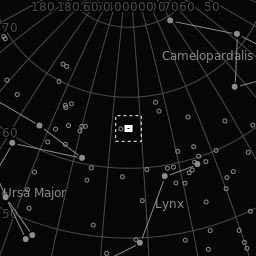
NGC 2403
Spiral galaxy in the constellation of Camelopardalis.

Spiral galaxy in the constellation of Camelopardalis.
NGC 2403 is a spiral galaxy in the constellation of Camelopardalis in the northern hemisphere. It is about 10-12 million light years away from the solar system and has a diameter of about 50-70,000 light years. The galaxy is a member of the M81 galaxy group and has an apparent brightness of +8.2 mag. This makes it one of the brightest galaxies in the northern sky, which was not included in the Messier catalogue.
| Object: | NGC 2403 |
| Date of exposures: | 06.02.2018, 07.02.2018 |
| Distance: | 11 Mio. Lightyears |
| Exposures: | RGB: 90 x 420 Sec., CLS: 37 x 520 sec., Sum: 15,8 hrs. |
| Telescope: | 10'', F4 Newton |
| Focal length: | 1000 mm |
| Filter: | Astrodon RGB E-Series, Astronomic CCD CLS |
| Camera: | Atik 460Exm |
| Guiding: | Off Axis Guider, Lodestar |
| Mount: | EQ8 |
In the center of this galaxy are several large open star clusters with massive, very hot stars embedded in HII regions. From these regions we receive H-alpha, ultraviolet and even soft X-ray radiation.
The first of the massive stars created here have already exploded as supernovae. Their shock waves have heated up the hydrogen gas of the respective star formation region to such an extent that it emits soft X-ray emissions. The rest of the unaffected gas is excited to glow in the hydrogen lines by the ultraviolet radiation of the massive stars that currently exist. These also contribute to observed distant UV radiation.
In 2004 the Supernova 2004dj erupted in this galaxy. Already in 2002, SN 2002kg and before that SN 1954J was observed in NGC 2403.
NGC 2403 was discovered on 1 November 1788 by the German-British astronomer Wilhelm Herschel.